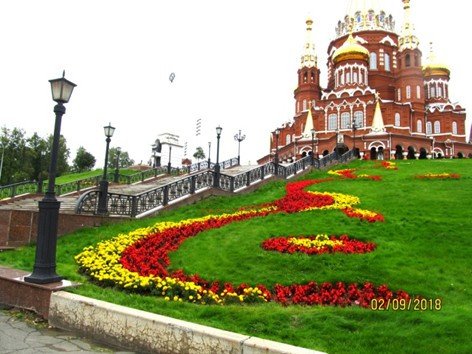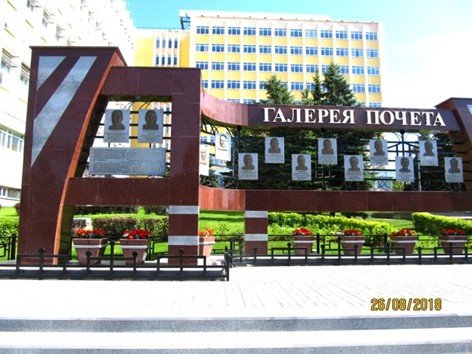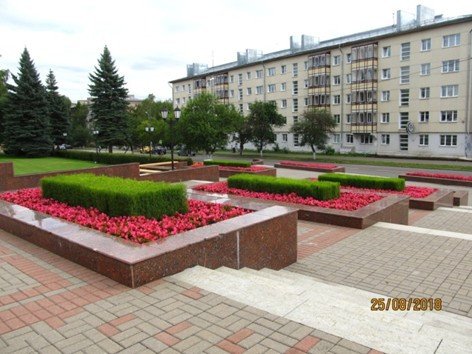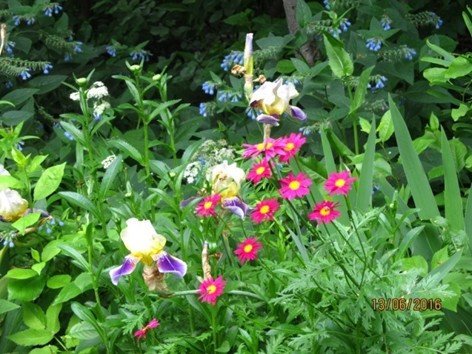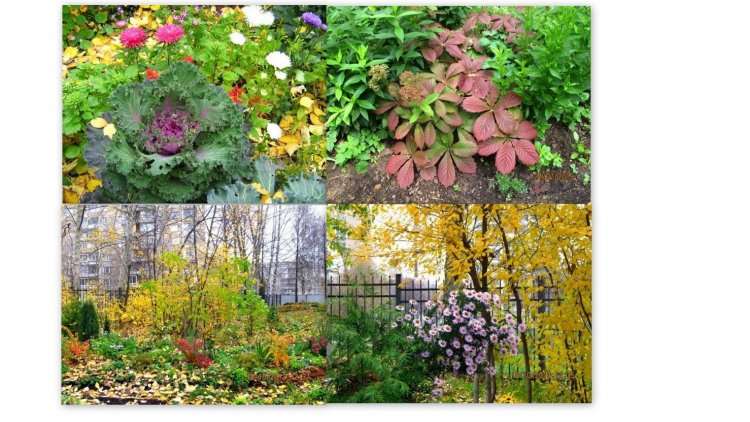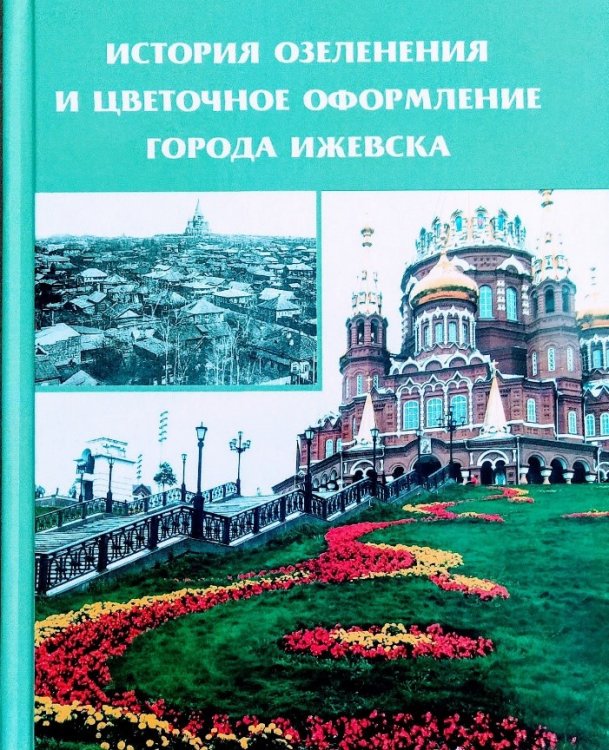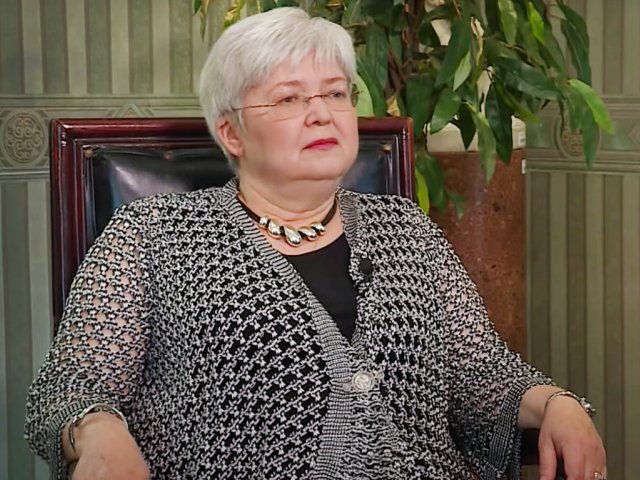Experts from Udmurt Federal Research Center of the Urals Branch of RAS (Izhevsk, Russia) are involved in a years-long effort on studying floral and ornamental design of cities of the Republic of Udmurtia. A study of the history of the problem and an estimate of the ecological condition of green spaces and flower beds reveal the factors of the quality of landscaping work and the level of species diversity
Ecological and floristic studies carried out by Ural scientists will help discover the recreational potential of urban areas and come up with highly esthetic designs. Landscape gardening in urban settings, especially in large industrial cities, not only demands adherence to an optimum sanitary and disease prevention regimen but also calls for ornamental flower planting. There are manifold requirements concerning landscaping of hospital sites, government and office buildings, buildings and parks of cultural and historical heritage. Guidelines concerning the choice of planted ornamental species preclude the use of allergenic and poisonous plants in urban landscaping. A successful color design of flower beds and planting will ensure an attractive and environmentally healthy space for recreation.
Russian scientists have completed their monitored of plants that may be promising for the landscaping of Izhevsk and other cities of the Republic of Udmurtia in a moderate continental climate. They identified the range of plant species used in flower beds along with rare and novel introduced plants. Using an improved method for estimating the quality of the visual environment, experts provided their analysis of ornamental properties and quality of flower beds. Experts’ scientific approach and practical recommendations will help deal with emergent problems, renew the recreational zone and increase its esthetic appeal.
Nadezhda Mikhailovna Kuzmina is a senior researcher of the Plant Introduction and Acclimatization Department of the Udmurt Federal Research Center under the Urals Branch of RAS
Researchers from the Plant Introduction and Acclimatization Department of the Udmurt Federal Research Center of the Urals Branch of RAS (Izhevsk) – Doctor of Agricultural Sciences, Chief Researcher Alexander Vladimirovich Fedorov, candidate of agricultural sciences, senior researcher Olga Albertovna Ardasheva and senior researcher Nadezhda Mikhailovna Kuzmina – talked about how studies of the state of urban landscaping in Udmurtia revealed problems in floral ornamentation of urban spaces and how did the dynamics of landscaping evolve over 80 years, explained what goes into creating healthy and comfortable flower spaces, and presented a monograph that reflected the results of multiple years of work.
Why does “green construction” play such an important role in the comfortable life of citizens. Particularly, what is special about floral and ornamental design of modern industrial cities?
“Flowers play an important role in human life. Flowers celebrate our birth and accompany us to our final resting places. Flowers are with us at all solemn moments. We give them to our loved ones. A rich natural color range comes with flowers. It has been proved that color can have a strong emotional effect and to affect the mood of a person. Ornamental flowering with the right choice of color components would relieve anxiety and stress, reinvigorate and add joy to life. Optimization of the urban environment is a highly relevant problem today. Ornamental plants improve the visual appeal of urban landscape. The quality of the landscape esthetics and its emotional and psychological comfort depend on the quality and competent execution of the floral design. All these factors are especially relevant in urban spots designed for short-term recreation (squares, boulevards, parks, embankments, strolling paths),” Nadezhda Kuzmina responded.
What issues are faced today in floral design of Izhevsk urban landscape (given that this is one of the largest industrial centers of the Urals, and natural zones of Udmurtia have undergone a significant transformation)?
“Our monitoring revealed several major problems in the floral design of urban space: the “flowerless” spring period, lack of ornamental flowers in squares, widespread use of expensive flower beds planted with annual species. More than half of flower beds in downtown areas of cities of Udmurtia were composed exclusively of annual species while the species diversity of annual plants comprised a meager 26% of the total identified range of herbaceous ornamental plants. Perennial species were noted to be hardy and efficient, testifying to a potential of their wider application. In most of urban squares studied by us there was a lack of floral and ornamental design. The range of perennial herbaceous plants identified by us can be used for the planting of mixborders that would bloom continuously from spring to fall. Squares and boulevards of the cities of Udmurtia mainly feature flat flower beds of annual plants. As such flower beds are only discernible at a close range, it would be a better option to use geoplastics techniques. Studies of the ornamental planting in cities of Udmurtia show that flower beds in downtowns are often neglected,” explained the employee of the Udmurt Federal Research Center.
Izhevsk, 2017. Ornamental flowerbeds near the Izhevsk City Administration, Pushkinskaya Str.
Izhevsk, 2018. Slope landscaping near the St. Michael the Archangel Cathedral.
Izhevsk, 2018. The Hall of Honor of the Axon Concern features flowerbeds in granite with red pelargonium.
Izhevsk, 2018. Flower landscaping in a square at the main entrance to the residence of the head of Udmurt Republic.
For a scientifically sound evaluation of the state of landscaping in Izhevsk, the Udmurt scientists have traced the progress of landscaping in the city over 80 years (from 1918 to 2018). Specialists’ effort spanned several stages the essence of which was revealed in detail by Alexander Fedorov: “Landscaping in Izhevsk evolved together with the city, largely depending on economic opportunities, the level of cultural development of society, the development of economic relations in society, and the development of technology and materials (the latter factor came into play at the most recent, modern stage of landscaping). Taking into account organizational and artistic approaches and the application of rules and techniques in Izhevsk’s history of landscaping, seven periods can be identified. For each period we invented names that seem to us to most accurately reflect or characterize the contemporary trends in landscaping:
Alexander Vladimirovich Fedorov – Doctor of Agricultural Sciences, chief researcher of the Plant Introduction and Acclimatization Department of the Udmurt Research Center under the Urals Department of RAS
Stage 1, archaic – 1921 to 1932, the beginnings of the urban “green construction.” Landscaping was carried out without any plan, mainly as a part of annual Forest Day campaigns and had hardly achieved any noticeable results. The city’s first park of culture and recreation opened on the banks of the Izhevsk Pond with a total area of 100 hectares, gardens and squares were expanded, first street landscaping effort completed covering 12 km in length. The first nursery garden came into operation at the City Committee of Services and was expanded to 5 hectares. A 500 m² greenhouse was built. A special interdepartmental committee on landscaping was organized. Workers from the city and the plant became involved in landscaping.
Stage 2, planned – 1932 to 1940, “green construction” is developed in a planned manner. This stage of green construction in Izhevsk is characterized by planned organization of landscaping. Activities for the protection of green spaces included into the work plan. A broad and systematic public awareness campaign was carried out to stress the importance and value of landscaping for the city. The list of green construction sites in the city was expanded. At the town of Sarapul, the first nursery of woody fruit and berry and ornamental species was laid to meet landscaping needs of cities of Udmurtia.
Stage 3, postwar reconstruction – 1946-1958, when the system of green spaces was restored. This stage features an integrated approach to the restoration and development of green spaces in accordance with the development plan and architecture of the city. For the first time ever, maintenance of green spaces was included in the landscaping work plan.
Stage 4, guided by science and procedure – 1959-1990, the period of “green construction” in an industrial city. It is characterized by a scientific approach to the problem of urban landscaping. The first detailed project of city planning and development was developed, including a plan of green spaces of the city. The landscaping project was informed by an analysis of existing green spaces taking into account soil and climatic conditions and seeking to provide a comfortable urban environment for the residents. The public played a significant role in city landscaping at the time due to the establishment and operation of the Udmurt Republican Council of the All-Russian Society for the Conservation of Nature. Green spaces in the city were developed in line with Izhevsk Planning and Development Plan prepared in 1951 by the Lenoblproyekt Design Institute. In early 1960s, the city of Izhevsk was developing in strides. New residential areas and manufacturing enterprises were under construction. Naturally, the previously adopted landscaping project for Izhevsk was becoming obsolete, and a need was felt to develop a new project to accommodate changes. In 1961, the Lengiprogor Institute designed a new urban planning project for the city of Izhevsk which was being implemented until the end of the 1980s.
Stage 5, transitional – 1991 to 1999. This period is characterized by the lack of landscaping development in the city and a sharp reduction in funding of the associated industries. Data on tree and shrub planting has been unavailable since 1994. The All-Russian Society for the Conservation of Nature is mainly concerned with the protection of nature and taking care of green spaces. After 1994, lack of opportunities as well as interest in landscaping is evident on the part of executive authorities. There is even less involvement in long-term planning to ensure comfortable conditions for the residents of the city.
Stage 6, recovery – 2000 to 2007. This was the beginning of a new stage of green construction; since 2000, landscaping of the city has been mainly the job of the municipal enterprise, State Farm of Ornamental and Flower Species. Activities are carried out under municipal orders (within the limit of apportionments in the city budget). Since 2001 the scope of landscaping has increased by 56%, including a 37% increase in municipal orders and a twofold increase in contractual orders. A new Master Plan for the planning and construction of the city of Izhevsk was approved in 2007, developed by CJSC Udmurtgrazhdanproekt.
Stage 7, “the designer stage” – 2008 to 2020. This period is characterized by the introduction of borrowed trends in the design of urban green spaces. Scientific basics and green construction techniques are often sacrificed to a significant extent to meet the moment interests and fulfill the desire to implement fashionable trends in shaping natural landscapes of the urban environment. Increased activity in reconstruction of older landscaping facilities is noteworthy, along with the use of new building materials and small architectural objects. There are some errors in reconstruction projects that impair the comfort of the recreation environment due to violation of the recommended ratios of spatial structure types and the breaking of visual connections with the surrounding landscape.”
How has the “fashion” for flower beds evolved with the change of epochs and scientific achievements of selection? What is the range of species diversity over the 80-year period?
“Changes in “fashion” for flower beds in Izhevsk floral designs are subject to general trends in the country and the world. For example, in the Soviet period, at the fourth stage of development in 1970s and 1980s, canna was a frequent fixture. In mid-2000s, the landscape style became more prevalent in design, with citizens contributing readily to inner-yard landscaping. Inner-yard flowerbeds feature a remarkable diversity of exotic flower species, mainly perennial ones, and a wide variety of traditional species. In general, it can be noted that species diversity has been increasing over the entire history of landscaping. Recently, exotic tree crops can be found in the city, such as staghorn, which are quite successfully growing and developing. Microclimatic conditions in the city are better, milder than in the surrounding country, so more heat-loving plants take root better,” the Izhevsk researcher noted.
To assess the ecological state of green spaces, in particular, the quality of flower beds, scientists used the Methodology for Estimating the Ecological State of Green Spaces of Public Use of St. Petersburg, which takes into account such parameters as the surface of the flower bed, habitus and ornamental value of plants, the presence of fallen leaves, soil condition, planting density and contamination.
As emphasized by Nadezhda Kuzmina, “this methodology meets the necessary requirements for evaluating flower bed quality. The latter effort, in turn, was carried out in three categories:
1. good condition of the flowerbed (3 points) – the surface of the flower bed is carefully graded, the plants are well developed and esthetic, there are no weeds and fallen leaves, the soil is loose and moist, flower sapling planting guidelines are complied with;
2. satisfactory state of the flower bed (2 points) – the surface of the flower bed exhibits noticeable irregularities, there are gaps of up to 10% of the bed area, plants are normally developed but there is withering or weeds occupying no more than 10% of the area of the flower bed or the total number of ornamental plants, the soil is compacted and dry;
3. unsatisfactory state of the flower bed (1 point) – the surface of flower bed area is roughly graded, there are lumps up to 30% of the area of the bed, plants are poorly developed, have little ornamental value or a significant part of them (more than 10%) has withered or is withering, weeds occupy more than 10% of the flower bed area, the soil is dense and dry.
To assess the ornamental value of flower beds used in the floral design of the cities of Udmurtia, the Plant Introduction and Acclimatization Department of the RAS Urals Branch has developed a 4-point appraisal scale taking into account the laws of floricultural set design: 4 points – patterned flower beds (carpet beds), colors chosen according to the laws of harmony, the height and location of plants in mixborders corresponds to the laws of floristic set design; 3 points – the color scheme is not entirely harmonious or monotonous, flower cultures are in good condition or the design of the object adheres to the laws of harmony but highly contaminated with weed grass; 2 points – random planting order, flower cultures in good condition, a small amount of weeds; 1 point – random planting order, flower cultures overgrown with weeds.”
The Udmurt researcher noted that “even though there are other methods for evaluating the ornamental value of flower beds, they are unsuitable for our research – they do not have the versatility to accommodate to different types of flower beds or are difficult to apply from an organizational point of view. The expert estimate method was also applied, involving of specialists such as artists, naturalists and travelers (K. D. Fayn, 1980). An estimate of landscaping and esthetic resources of a territory (Dirin, 2000) based on comprehensive objective criteria. A questionnaire was used for mass surveys. Numerical ratios in flower beds were considered (Sokolova, 2004), i.e., the laws of floristic set design taking into account series of preferred numbers. Sokolova’s method is closest to our proprietary development which takes into account the laws of harmony. We needed a universal estimate for all types of flower beds based on the laws of floristic set design, taking into account the qualitative state of flower beds.”
Scientists from Izhevsk monitored the floral ornamentation of the most frequented parts of some industrial centers of Udmurtia: Izhevsk, Sarapul, Votkinsk and Glazov.
In 2019, 98 species of ornamental herbaceous plants were identified in surveyed flower beds of the cities of Udmurtia. Annual crops – 25 species. Perennial crops – 73 species. The greatest species diversity of ornamental herbaceous plants was identified in Izhevsk, numbering 70 species. Glazov held the second place with 49 species. Sarapul had 39 species and Votkinsk, 32 species.
The most common annual species include spreading marigold (Tagetes eresta L.), hybrid petunia (Petunia hubrida Vilm.), perpetual begonia (Begonia semperflorens Link et Otto), silver ragwort (Cineraria maritima L.), sweet alyssum (Alyssum maritimum Lam.), flossflower (Ageratum houstonianum Mill.), spurflower (Coleus hybridus), lobelia (Lobelia erinus L.), Vittrock viola (Viola × vittrockiana Gams ex Hegi), pelargonia (Pelargonium L'Hér. ex Ait.), scarlet sage (Salvia splendens Sellow ex Nees.). These cultivars are used mainly in regular-style flower beds.
Cities of Udmurtia, 2018-2019
Left top: SARAPUL, descent to the embankment, 2019; right top: IZHEVSK, floral design of the square (main entrance) of the residence of the head of the Udmurt Republic, 2018; left bottom: GLAZOV, Monument in honor of responders to man-made accidents, Revolyutsionnaya Str., 2018; right bottom: VOTKINSK, Votkinsk Plant, floral design, 2019.
Are there foreign plant species?
“Several alien plants were discovered in the floral design of cities. According to literature (O. G. Baranova, E. N. Bralgina, 2015. Invasive Plants in the Flora of the Udmurt Republic), 100 invasive plant species were identified in Udmurtia. 6 species of ornamental herbaceous plants from this list are used in flower beds that were surveyed: wild cucumber (Echinocystis lobata (Michx.) Torr. et Gray.), large-leaved lupine (Lupinus polyphyllus Lindl.), columbine (Aquilegia vulgaris L.), elf-wort (Inula helenium L.), Canadian goldenrod (Solidago canadensis L.), butter tree (Kochia scoparia s.l.). Group 1, the most aggressive species, includes: wild cucumber (Echinocystis lobata), large-leaved lupine (Lupinus polyphyllus),” Nadezhda Kuzmina explained.
How do you rate the quality of flower beds in these cities?
“In 2019, there was an improvement in the quality of the studied floral landscaping in all cities of Udmurtia compared to 2018. More than half of the studied flower beds in all cities of Udmurtia had high quality scores in 2019 (3 points). Accordingly, the proportion of low-quality flower beds declined. In addition to better care for flower beds, weather conditions were also favorable to better quality of flower beds in 2019 compared to 2018. In July 2019, precipitation was more copious than usual – 73 mm of precipitation (125% of the norm). In 2018, only 38 mm (65% of the norm) of precipitation fell during this period while temperatures stayed high (25-30°C). The wet weather of July 2019 positively affected the quality of the vegetative part of ornamental plants, especially perennial crops, but was detrimental to the flowering quality of some annual plants (such as petunia). Customer inspections became more rigorous – apparently, this is due to Izhevsk holding events in 2019 to commemorate the 100th anniversary of the birth of the legendary small arms designer M. T. Kalashnikov. In Izhevsk, the share of high-quality flower beds increased in 2019 compared to 2018 from 35% to 60%, while that of low-quality beds decreased from 13% to 4%, respectively,” the Ural biologist cited the figures.
What are the adverse factors for flower bed quality?
“During the monitoring of floral decoration, several drivers of degradation in flower bed quality and ornamental value were identified: non-timely planting of flower species, poor quality of seedlings, inadequate plant care, inadequate monitoring on the customer’s part, weather conditions, failure to comply with planting standards, especially in carpet-type beds – 13-15 plants/1 m². To date, to improve quality and esthetic appeal, many cities of Russia are issuing recommendations for compacted planting of annual crops in carpet-type flower beds – 50-100 plants/m²,” the scientist reported.
In your work, you have identified rare and new herbaceous introducents. What are they and what is their role in the landscaping of Izhevsk? How do they get along with decorative plantations?
“Mixed flower beds use cultivars less frequent in urban landscaping: common zinnia (Zinnia elegans Jacg.), garden candytuft (Iberis umbellifera L.), callistephus (Callistephus chinensis (L.), chalk plant (Nees, Gypsophila elegans M. Bieb.), large-flowered flax (Linum grandiflorum Desf.), annual dahlia (Dahlia variabilis Desf.), snapdragon (Antirrhinum majus L.), Mexican aster (Cosmos bipinnatus Cav.), nasturtium (Tropáeolum május L.), pot marigold (Calendula officinalis L.), California poppy (Eschscholzia californica Cham), annual sunflower (Helianthus annuus L.).
Perennial cultivars are mainly used in mixborders. Rarely used perennial herbaceous plants have been identified: Syrian silkweed (Asclepias syriaca L.), Persian cornflower (Centaurea dealbata Willd.), Japanese knotweed (Fallopia sachalinensis (F. Schmidt) Ronse Decr.), Faassen’s catnip (Nepeta × faassenii), Crisp tansy (Tanacetum vulgare Crispa), wormwood (Artemisia abrotanum L.), plume poppy (Macleaya cordata (Willd.) R.Br.). Rare perennial plants mostly grew in mixborders. Ornamental value was ranked between high and medium. New plants increase the biodiversity of flower beds, but their wider use must be preceded by a study of their properties: the chemical composition of plants, ecological plasticity, level of aggressiveness,” said Nadezhda Kuzmina.
Summer bloom of perennial plants.
What comprised the range of ornamental flowering plants used in landscaping of Izhevsk and what was the principle behind their choice?
Olga Albertovna Ardasheva – Candidate of Agricultural Sciences, senior researcher at the Plant Introduction and Acclimatization Department of Udmurt Federal Research Center under the Urals Branch of RAS
“The range of ornamental plants identified using the Maevsky classifier in the studied flower beds of Izhevsk numbered 70 species. There are 15 annual plant species and 55 perennial plant species. Flat patterned beds and border beds feature low-growing species of long-flowering and ornamental leafy annual species: sweet alyssum (Alyssum maritimum), spreading marigold (Tagetes patula), hybrid bushy petunia (Petunia hubrida), salvia (Salvia splendens), wax begonia (Begonia semperflorens), cineraria (Cineraria maritima), mock cypress (Kochia scoparia), flame nettle (Coleus blumei). Spring designs use varieties of Vittrock viola (Víola × wittrockiána) and tulips (Tulipa L.). Less frequent are annual cultivars planted near offices, shops and other commercial buildings: annual dahlia (Dahlia variabilis), Mexican aster (Cosmos bipinnatus), lobelia (Lobelia erinus L.), snapdragon (Antirrhinum majus), pot marigold (Calendula officinalis). Suspended vases feature hybrid petunia (Petunia hubrida) of creeping varieties. For flat patterned flower beds, varieties of ornamental plants are chosen taken into account color harmony. Mixborders with perennial plants do not necessarily comply with the laws of floricultural set design. They mainly feature random plantings,” Olga Ardasheva reported.
Were recognized, adapted varieties of perennial plants considered for landscaping purposes for their simple and understandable care requirements? (Or, conversely, exotic species not typical of these latitudes?)
“Izhevsk city landscaping is based on recognized species and varieties of widely used annual plants. For mixborders, winterhardy perennial plants with simple care requirements are preferred. The choice of plants for mixborders is mainly random, without expert input,” the scientist stated specifically.
What recommendations can you make to create a more favorable visual urban environment, based on the experience of your scientific team with green construction and landscaping?
“One of the problems identified during the study of the most visited facilities in the central part of Izhevsk is the “flowerless” spring period and empty territories of the squares. In the spring, most flowerbeds, border beds and parterres stand empty. Large areas of squares surveyed have no floral landscaping. A recommendation can be made that one uses for squares early-blooming small-bulbed cultivars: spring saffron (Crocus vernus (L.) Hill.), Armenian hyacinth (Muscari armeniacum Leichtlin ex Baker), Siberian squill (Scilla siberica Andrews), snowdrop (Galánthus nivális L.), etc. These cultivars begin to bloom even before the beginning of the vegetation of lawn grasses. Small-bulb cultivars are mainly planted in circles around tree trunks and shrubs. Narcissus (Narcissus L.) can be planted under the turf cover. These cultivars do not need to be dug out and replanted every year. They can grow for many years in one place. Some of them are able of seed reproduction and produce whole flowering glades in April and May. An example is the park of the Metallurg sanatorium in Izhevsk, whose territory has been covered with flowering primroses since April: Armenian hyacinth (M. Armeniacum), hyacinth (Hyacínthus L.), narcissus (Narcissus), auricula (Prímula L.), lungwort (Pulmonária L.) and others. Early-flowering species in squares will provide a distraction from the empty beds for annual cultivars.
Perennial cultures should be used more broadly. Botanical gardens and other organizations offer an extensive species range for urban landscaping. The effectiveness and unpretentiousness of perennials has been proved in mixborders studied. Even in ungroomed mixborders, most perennials had appreciable ornamental appeal until the end of the season. Vertical landscaping by perennial vines is underutilized. Perennial vines could add a vertical component to the landscaping system. A study in other cities of Russia showed that vertical landscaping with perennial vines is inn demand among urban residents,” Olga Ardasheva justly suggested.
The researcher noted that “the central part of Izhevsk mainly relies on expensive flat beds with carpet-like planting of flowering and ornamental cultivars. The disadvantage of these beds is the lack of vertical elements that would make floral decoration three-dimensional. Large-sized plants can be used as vertical elements: garden canna (Canna × hybrida hort.), mock cypress (Kochia scoparia), castor-oil plant (Ricinus L.), etc. The use of garden canna in modular flower beds on the pedestrian bridge of Central Square gave this composition both three-dimensional and exotic appearance. Garden canna (Canna × hybrid) is widely used in the design of the park of the Metallurg sanatorium and in the Plant Introduction and Acclimatization Department, in the design of the territory of Udmurt Federal Research Center under the Urals Department of RAS. The floral design of central streets mainly comprises diverse mixborders. For central streets with a historical past, floral design should be at a high level. We could install beautiful parterres along the most frequented sections of the streets at a certain distance from both sides of the street and adorn them with flower cultivars of a single species. Identical parterres would ensure a more organized appearance of different mixborders and flower beds next to offices, shops and cafes.
A big downside is the lack of floral ornamentation near the monuments to the heroes and respected people of Udmurtia. Floral design is lacking at entrances of cultural establishments (museums, theaters, etc.) Memorial cultural facilities were and are always adorned with flowers as a sign of respect. Entrance spaces of museums need to be embellished with floral cultivars. Flowers steal one’s sight with their beauty and lively energy, inviting to visit a particular establishment. This technique has long been known and is used by many in the design of entrance spaces of offices, stores, etc. Cultural establishments are where ornamental and floral design is most needed.”
“Izhevsk is the capital of the Udmurt Republic. The territories surveyed by us are in downtown Izhevsk. They all are cultural objects with a historical heritage. Guests of Izhevsk first of all would go to see the Central Square, the Victory Square and the residence of the head of the Republic. There are many offices, cafes, banks, shops on Lenin Street, so there are many citizens and guests of Izhevsk in the street in afternoon and evening. Flower decoration of the central part of Izhevsk, the one most frequented by the guests of the city and the residents themselves, should always be at a high level,” Olga Ardasheva said.
What is the feedback from residents concerning the execution and visual design of the current landscaping of Izhevsk?
“No opinion polls were held. But today, residents of cities raise the bar not so much for the number of flower beds but for their quality, sophistication and attentive care. It takes a lot of expertise to create a comfortable visual urban environment. When designing flower beds, it is necessary to take into account the laws of floral set design and color science, to select an assortment of flowering ornamental plants to ensure continuous blooming from early spring to late fall. Squares and boulevards of the cities of Udmurtia mainly feature flat flower beds of annual plants. As such flower beds are only discernible at a close range, it would be a better option to use geoplastics techniques. Flower beds comprising plants of different heights allow one to create three-dimensional compositions in which vertical accents can set the rhythm. Empty lawns in squares call for mixborders made of unpretentious perennial plants inclusion of early-flowering species to delight one’s eyes with their greenery and bloom as early as May. For the high quality of flower beds, professional and assiduous systematic plant care is necessary,” the scientist commented.
Fall bloom of ornamental herbaceous plants in the “Continuously blooming garden”
The years-long effort of experts from the Plant Introduction and Acclimatization Department culminated in a monograph, History of Green Space Development and Floral design of Izhevsk published this March to commemorate the 100-year anniversary of the Udmurt Republic.
The book published by researchers from the Udmurt Federal Research Center under the Urals Department of RAS is the first monograph in the history of the Republic of Udmurtia dedicated to the formation and development of landscaping in the region.
The book is based on information from the Central State Archive of the Udmurt Republic: information regarding the landscaping and improvement of the city of Izhevsk from 1918 to 1997, reports on “green construction” from municipal and urban development services going back to 1920s and 1930s.
According to Alexander Fedorov, who led this long effort, “studies of ornamental plants in the Department’s “Continuously Blooming Garden” begun in 2006, and studies of archival materials commenced in 2008. Landscaping and green space development are one of the three main areas of research activities of our department, so they were carried out under the budget and were included in the state assignment plan. In addition, data for the monograph were obtained from research in another area of department’s research – plant introduction and biodiversity conservation.”
To sum up, a landscaping system should be devised within the framework of urban planning and has to be in line with the features of the natural landscape, environmental situation and industrial infrastructure. After all, floral ornamentation selected by experts not only makes the urban environment attractive and environmentally healthy but also shapes the individual appearance of the city.


